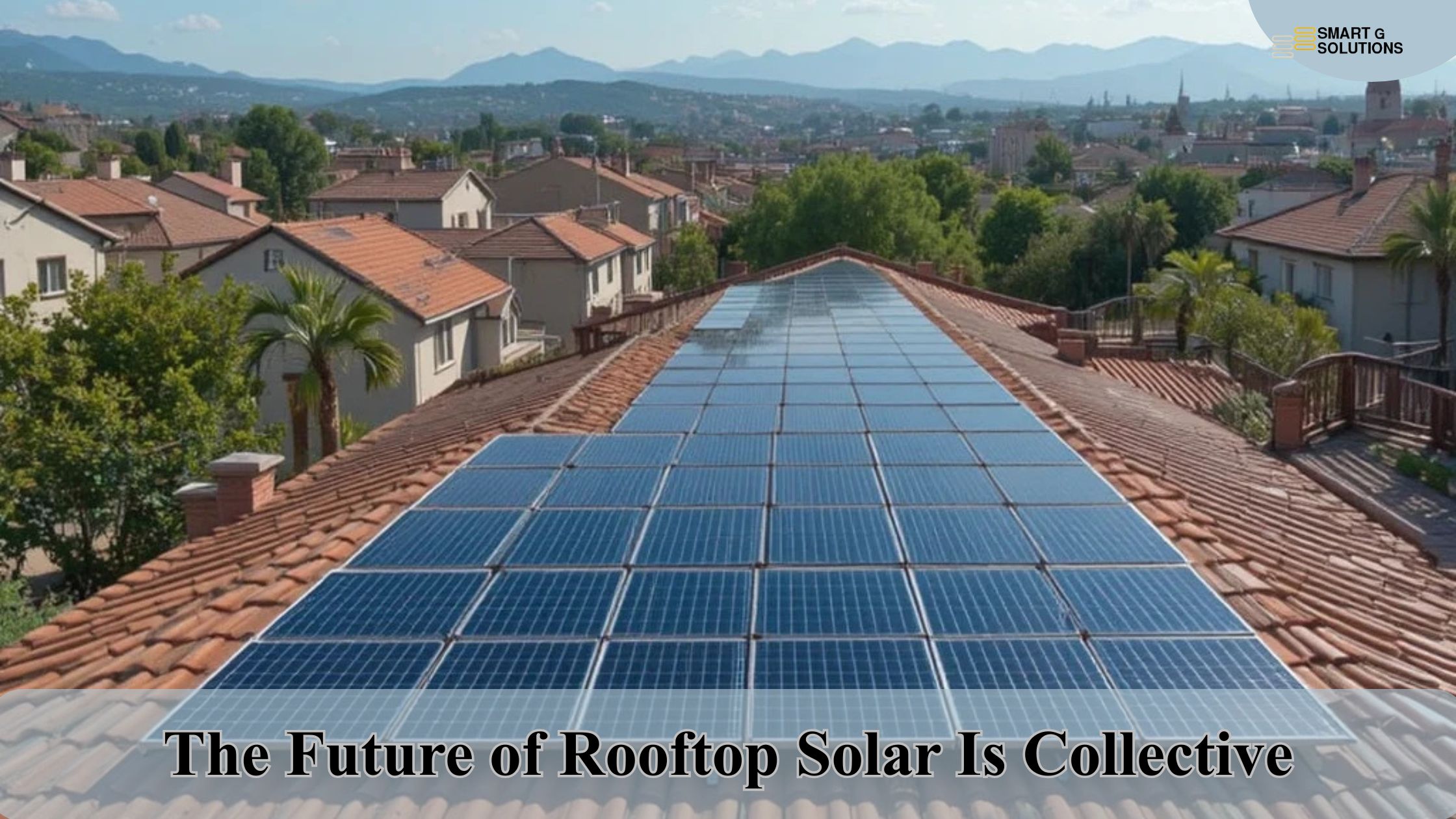Introduction
As global demand builds for sustainable energy sources, roof-top solar power has emerged as one of the most effective ways to reduce dependence on fossil fuels. Clean, renewable and increasingly affordable, it remains limited in this role to a small segment of home owners and businesses. High up-front costs are part of the reason for that limitation, and insufficient space on rooftops just makes matters worse; meanwhile maintenance duties are still another problem.
Now, however, a new model which completely changes the lay of the land is collective rooftop solar. This turns solar ownership from individual bolt-on applications to group involvement in other words, an entire community takes part. Rather than each household installing its own solar panels, neighborhoods, apartment complexes and businesses in cooperation will be able to install large-scale systems that produce natural power more efficiently into local grids — without any connections whatsoever. This is a significant change for renewable energy: it includes everyone, helps everyone, and is driven by everyone.
The Movement Towards Collective Solar
By its very nature, traditional rooftop solar systems “make for individual buildings”, where each property owner installs panels to generate electricity and in some cases might also sell surplus power back into the power system. This system works well for standalone houses. In urban settings however, it may be less practical as there is insufficient roof space or shared buildings make installation difficult.
This is obviated by collective solar. Multiple users can all benefit from one shared solar set-up rather than being constrained to each user having their own, thus relaxing those spatial constraints. The best roofs — those in apartment buildings, commercial buildings and community centers — are equipped with panels and the power produced is distributed among those users participating in the scheme.
Besides, the adoption of this model is growing in urbanizing regions where a solution to the question: my neighbors benefit,too? is urgently sought. In countries like India, policies such as Group Net Metering, Virtual Net Metering and Smart Gains are generating a broad multidimensional application for solar power. The result is an energy system that brings solar power to everyone, regardless of individual ownership of a specific piece land. It is also fair and equitable.
Why Collective Solar Makes Sense
1. Mutual investment and cost savings
The high initial investment in solar has been a major obstacle to its adoption. This is changed by the collective rooftop approach to solar systems, as costs can be shared among participants. Expenses are not paid in full by one individual for installation, equipment, and maintenance, but are divided according to the amount that people use generates electricity. It makes solar power affordable to a much larger audience than merely a few enthusiasts.
Larger systems also benefit from economies of scale – the per-unit cost of energy production goes down as installation size increases. Savings over the long term are considerable too, thanks to bulk purchases, streamlined installations, and centralized management.
2. Maximum use of space
In urban areas, the tops of buildings may sometimes offer little usable area because of obstacles such as shading and bad layout or structural reasons. Collective solar resources, however, are most effectively exploited across the entire community or complex by using only those roofs which are appropriate. For example, in an apartment complex panels can be installed on the building with the best sunlight exposure, while power goes to everyone.
This ensures that the whole area is used well and benefits each participant, no matter what their own roof may be like.
3. Maintenance and Management Made Easy
Individual roof systems have to be cleaned regularly, watched for performance, and occasionally repaired — tasks which most householders would find difficult. But a collective roof system allows general maintenance to be done at the community level by one contractor or committee for all participants.
That way, not only will the equipment maintain consistent performance but also its life will be extended. And while the equipment is taken care of by the contractor, you yourself need not have any share in this.
4. Scalable and Primed For The Future
The platform of collective solar resource systems provide the flexibility to grow when user numbers increase. This makes it an ideal platform for spreading across residential developments, business parks and school and college campuses.
Besides, these systems can be plugged straight into battery storage and smart grid technology. Together, that means more energy independence altogether! Communities can store excess power, balance loads efficiently, and even make money by selling power back to the grid — potential energy-smart neighborhoods are on the horizon.
Social and Environmental Impact of
The collective use of rooftop solar energy, however, brings more benefits than simply saving money or being efficient per se–it carries a strong social and environmental dimension.
- Community Sense: Through shared solar projects, residents, businesses, and even institutions can make something of themselves together. When people invest collectively in clean energy then they become responsible for their own path to sustainable living–which also results in greater unity and overall environmental awareness.
- Energy Fairness: Collective rooftop solar levels the playing field for renewable energy access. Even renters and others who live in buildings without their own rooftops can get involved, and receive the same benefits as single-family residences do.
- Sustainable Environment: Solar energy helps communities reduce their overall footprint. By replacing coal electricity with clean power, this action cuts directly into carbon emissions — it is not just an abstract measure on paper anymore.
- Local Economies Grow: Large-scale solar power stations create jobs for engineers, technicians and maintenance personnel; this helps economies just at the bottom green careers.
In sum, collective solar is a departure from private benefit to public good, whereby the consumption of energy takes on community attributes and values.
Role of Technology and Policy
The expansion of collective rooftop solar depends on incentives and innovations in technology policy.
Around the world, governments are increasingly aware of the models that shared solar utilize. In India, for example, policies as Group Net Metering (GNM) provide a means to share power from one solar farm with many users and then bill each person individually. Similar community solar schemes have been seen in Europe and North America too: they share ownership, are anchored on subscriptions.
Thanks to new technological developments, such as the use of smart meters, household Internet of Things (IoT) monitoring devices that are connected to the user’s smartphone, and mainstream AI-based data analytical tools, the transparency and reliability of energy tracking is greater than ever before.
The true energy distribution and correct billing between the customer and provider are both ensured with these systems.,Among the advanced capabilities of modern software platforms is the real-time generation, consumption, and saving monitoring (100% accurate).
Challenges in Implementation
While the collective model seems to offer every promise, it also carries several practical obstacles which have to be overcome for the idea to be accepted by ordinary people:
Regional Policy and Regulatory Differences: Policies and regulations will always be different in different places. It is thus quite difficult to install a standardized collective solar energy method.
Ownership and Distribution Agreements: Very accessible and simple regulations are needed to provide for clear, transparent agreements concerning the division of energy, costs, and savings among a group of parties sharing the responsibility with each other. A number of finance companies have been slow to adapt their business models to provide (commercial) support for community-based solar initiatives.
Financing Hurdles: Many financial institutions are still in the process of tweaking their lending models to cover community- based solar installations.
Awareness and Education: Many people have not even heard of collective solar models or how they fit into a community’s long-term financial and environmental plans.
Still, with better public outreach, relevant policies, and innovative financing, these obstacles can be overcome. Close cooperation between us energy providers and local communities will be essential to push large-scale solar across the board.
Conclusion
The future which outpatient in large cities is in support of collective or shared energy. As the world seeks cleaner supplies of electricity and some cities grow denser than ever before, collective rooftop solar power offers a way forward. It’s a scalable, affordable and inclusive method of getting everyone — not just individual homeowners — involved in the renewable energy revolution.
By leveraging smart technology and optimizing the potential of their roofs, communities will be able not just to achieve energy independence but also help global sustainability targets. Under the government’s support policies coupled with increasing public engagement, collective rooftop solar power is poised to change people’s imagination about electricity production—from a one-way, meshed network into what? Every rooftop will be switched on for you–an even brighter green eternal variety that transcends even those yellow wildflowers spilling like honey from an old jar.





